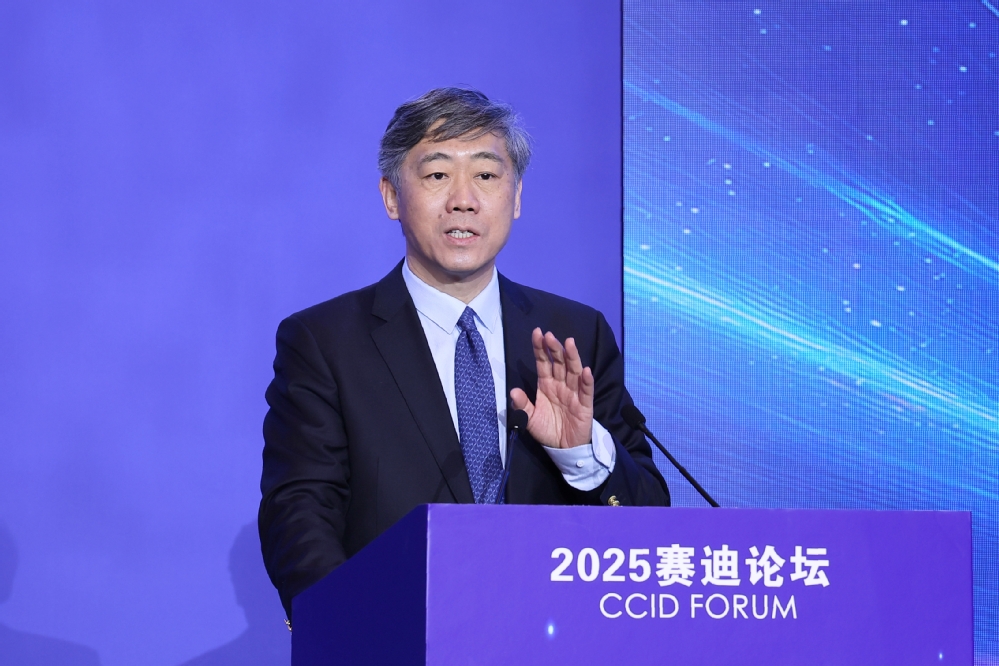David Daokui Li: Development of China's manufacturing industry in current era of widescale changes requires “breaking down barriers”
Originally published April 2, 2025, in Chinese by China Electronics News. Written by Wang Wei. Translated and edited by ACCEPT. Source: https://www.cena.com.cn/ia/20250402/126192.html
On April 1, the 2025 CCID Forum co-organized by the China Center for Information Industry Development (CCID Academy for Industry and Information Technology) and the New Industrialization Research Center of the Ministry of Industry and Information Technology (MIIT) was held in Beijing, China. David Daokui Li, director of the Academic Center for Chinese Economic Practice and Thinking (ACCEPT) at Tsinghua University, pointed out in his speech during the forum’s main proceedings that the development of China's manufacturing industry in the current era of widescale changes necessitates “breaking down barriers” and unleashing the potential of domestic demand, undertaking overseas expansion in an orderly manner that pays close attention to the concerns of the host country, and promoting “policies to readjust industries” while maintaining a sense of optimism for forward-looking technologies of the future.
Li observed that in the current complex international environment, global strategies for industrialization have undergone a repositioning, with the industrial security and industrial autonomy of all countries having since become a core concern, and with the establishment of local industrial capacity now representing an inelastic need for each country’s industrialization process.
At present, China's industrialization has made remarkable achievements that have garnered widespread attention, although there are also three “sweet vexations” that continue to persist.
First, the domestic demand in China’s market has lagged behind the development of its industrial capacity. Taking the motorcycle industry as an example, the “13-year compulsory decommissioning” policy, along with regulations in more than 100 municipalities that institute “bans and restrictions on motorcycles,” has led to a development dilemma wherein the “technology and production capacity exist without a market” for high-end motorcycles in China.
The second issue is a duplicative form of race-to-the-bottom competition. Overcapacity and excessive competition in the new energy vehicle industry, for instance, represents one such example. In fact, the competitive race to the bottom in many industries has been caused by China’s long-term established practice of “overemphasizing investment and production while underemphasizing consumption.”
Third, the ability to undertake transformations through the incorporation of cutting-edge technologies remains insufficient. In the field of artificial intelligence, although China leads the world in terms of the number of published papers, epoch-making AI applications such as ChatGPT are still emerging primarily in the United States, with advanced technologies not yet able to be successfully converted into practical use.
This year is the final year prior to culminating the 14th Five-Year Plan, while also representing a period to devise the layout for the upcoming 15th Five-Year Plan, which hence presents a favorable opportunity for reflecting on the path forward. From the perspective of government and economics, Li introduced four suggestions to this end.
The first is “breaking down barriers” and unleashing the potential of domestic demand. Li recommended relaxing unreasonable and outdated restrictions on consumption, such as lifting the ban in those municipalities instituting “prohibitions on motorcycles,” and lifting the restrictions on the use of various low-altitude aircraft operating below 500 meters, so as to free up the unrealized potential of China’s domestic demand and permit its massive unified consumer market to take shape.
The second is undertaking overseas expansion in an orderly manner that pays close attention to the concerns of the host country. China must avoid “jumping onto the bandwagon” when expanding into other markets, while taking the degree of acceptance of other countries fully into consideration. In this present era of momentous changes, every country has their own issues of national security to consider, which means that Chinese enterprises ought to also pay close attention to how best to properly and orderly expand overseas, not merely focusing on shorter-term interests but also fully considering cooperative production arrangements and the longer-term interests of host countries. On the one hand, the excessive competition of Chinese enterprises entering markets overseas can lead to “indigestion” from a supply glut in host countries, and on the other hand, the low-price competition between enterprises will meanwhile reduce the profitability of the industry.
The third is promoting “policies to readjust industries.” For mature industries, such as the new energy vehicle industry, China can follow the example of the electrolytic aluminum industry and set up a quota exchange mechanism for production capacity. Based on the premise of ensuring that overall production capacity remains unchanged, market mechanisms should be employed to implement a “negotiated turnover mechanism for regulating and controlling production outputs, in this way replacing unchecked increases in production capacities with a production trading system between enterprises.
The fourth is maintaining a sense of optimism for forward-looking technologies of the future. In view of the continued industrial development of humanity, it is necessary to maintain an attitude of openness towards the diversification of industrial technologies, while remaining wary of any “one-vote veto” on the part of industry experts when it comes to initially determining the potential subdivision of industries. Relevant industry research institutions need to fully play their role and continue to focus on and invest in forward-looking, higher-risk, and highly promising technologies and industries, even if such exploration may not immediately yield results.





